Decision-Making Biases and Their Impact on Wesfarmers' Performance
VerifiedAdded on 2021/06/14
|13
|4378
|140
Report
AI Summary
This report analyzes the impact of various decision-making biases on business strategies, using Wesfarmers as a case study. It explores cognitive biases such as excessive optimism, the illusion of control, familiarity heuristic, loss aversion, and sunk cost, explaining how these biases can affect managerial decisions and organizational outcomes. The report also discusses the influence of group factors, including groupthink and overconfidence, on the decision-making process. It provides real-world examples from Wesfarmers, such as the Homebase acquisition and the company's risk management policies, to illustrate the practical implications of these biases. The analysis aims to provide insights into how these biases can lead to both successes and failures in business, and how organizations can mitigate their negative effects. The report emphasizes the importance of recognizing and addressing these biases to improve decision-making processes within organizations, particularly in risk management and strategic planning. The report concludes by highlighting the importance of governance policies for groups and individuals, and the constant review of risk aversion and group thinking.
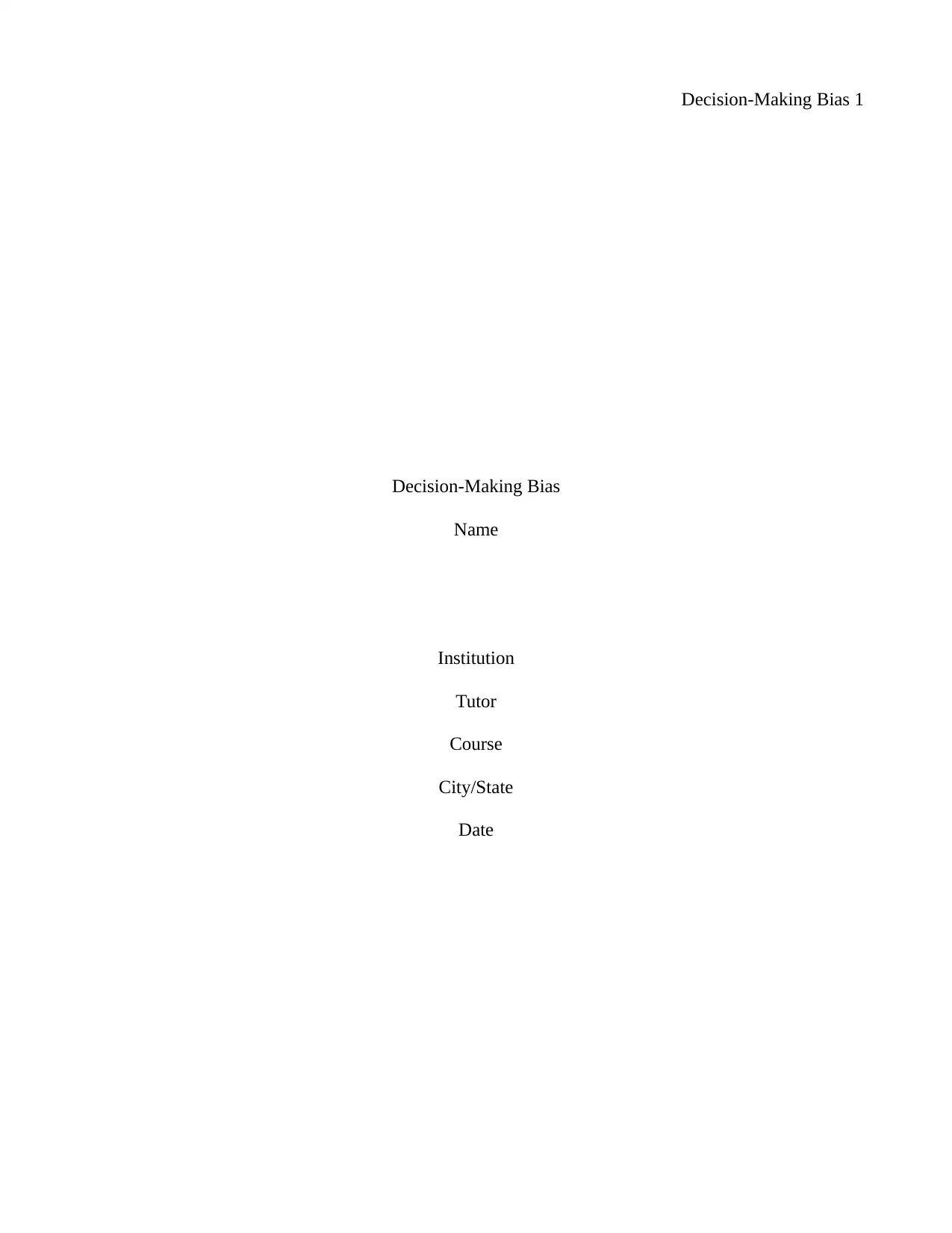
Decision-Making Bias 1
Decision-Making Bias
Name
Institution
Tutor
Course
City/State
Date
Decision-Making Bias
Name
Institution
Tutor
Course
City/State
Date
Paraphrase This Document
Need a fresh take? Get an instant paraphrase of this document with our AI Paraphraser
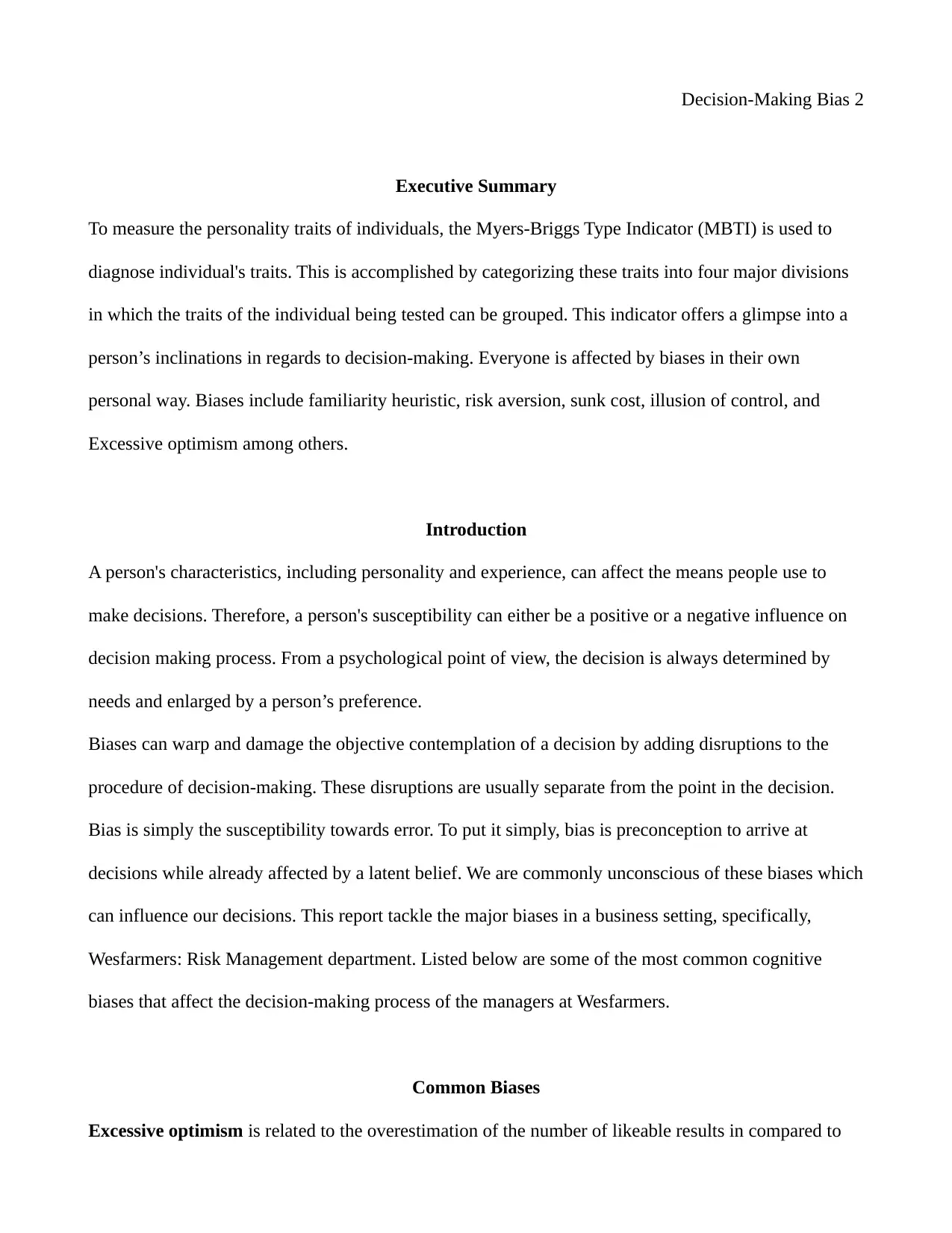
Decision-Making Bias 2
Executive Summary
To measure the personality traits of individuals, the Myers-Briggs Type Indicator (MBTI) is used to
diagnose individual's traits. This is accomplished by categorizing these traits into four major divisions
in which the traits of the individual being tested can be grouped. This indicator offers a glimpse into a
person’s inclinations in regards to decision-making. Everyone is affected by biases in their own
personal way. Biases include familiarity heuristic, risk aversion, sunk cost, illusion of control, and
Excessive optimism among others.
Introduction
A person's characteristics, including personality and experience, can affect the means people use to
make decisions. Therefore, a person's susceptibility can either be a positive or a negative influence on
decision making process. From a psychological point of view, the decision is always determined by
needs and enlarged by a person’s preference.
Biases can warp and damage the objective contemplation of a decision by adding disruptions to the
procedure of decision-making. These disruptions are usually separate from the point in the decision.
Bias is simply the susceptibility towards error. To put it simply, bias is preconception to arrive at
decisions while already affected by a latent belief. We are commonly unconscious of these biases which
can influence our decisions. This report tackle the major biases in a business setting, specifically,
Wesfarmers: Risk Management department. Listed below are some of the most common cognitive
biases that affect the decision-making process of the managers at Wesfarmers.
Common Biases
Excessive optimism is related to the overestimation of the number of likeable results in compared to
Executive Summary
To measure the personality traits of individuals, the Myers-Briggs Type Indicator (MBTI) is used to
diagnose individual's traits. This is accomplished by categorizing these traits into four major divisions
in which the traits of the individual being tested can be grouped. This indicator offers a glimpse into a
person’s inclinations in regards to decision-making. Everyone is affected by biases in their own
personal way. Biases include familiarity heuristic, risk aversion, sunk cost, illusion of control, and
Excessive optimism among others.
Introduction
A person's characteristics, including personality and experience, can affect the means people use to
make decisions. Therefore, a person's susceptibility can either be a positive or a negative influence on
decision making process. From a psychological point of view, the decision is always determined by
needs and enlarged by a person’s preference.
Biases can warp and damage the objective contemplation of a decision by adding disruptions to the
procedure of decision-making. These disruptions are usually separate from the point in the decision.
Bias is simply the susceptibility towards error. To put it simply, bias is preconception to arrive at
decisions while already affected by a latent belief. We are commonly unconscious of these biases which
can influence our decisions. This report tackle the major biases in a business setting, specifically,
Wesfarmers: Risk Management department. Listed below are some of the most common cognitive
biases that affect the decision-making process of the managers at Wesfarmers.
Common Biases
Excessive optimism is related to the overestimation of the number of likeable results in compared to
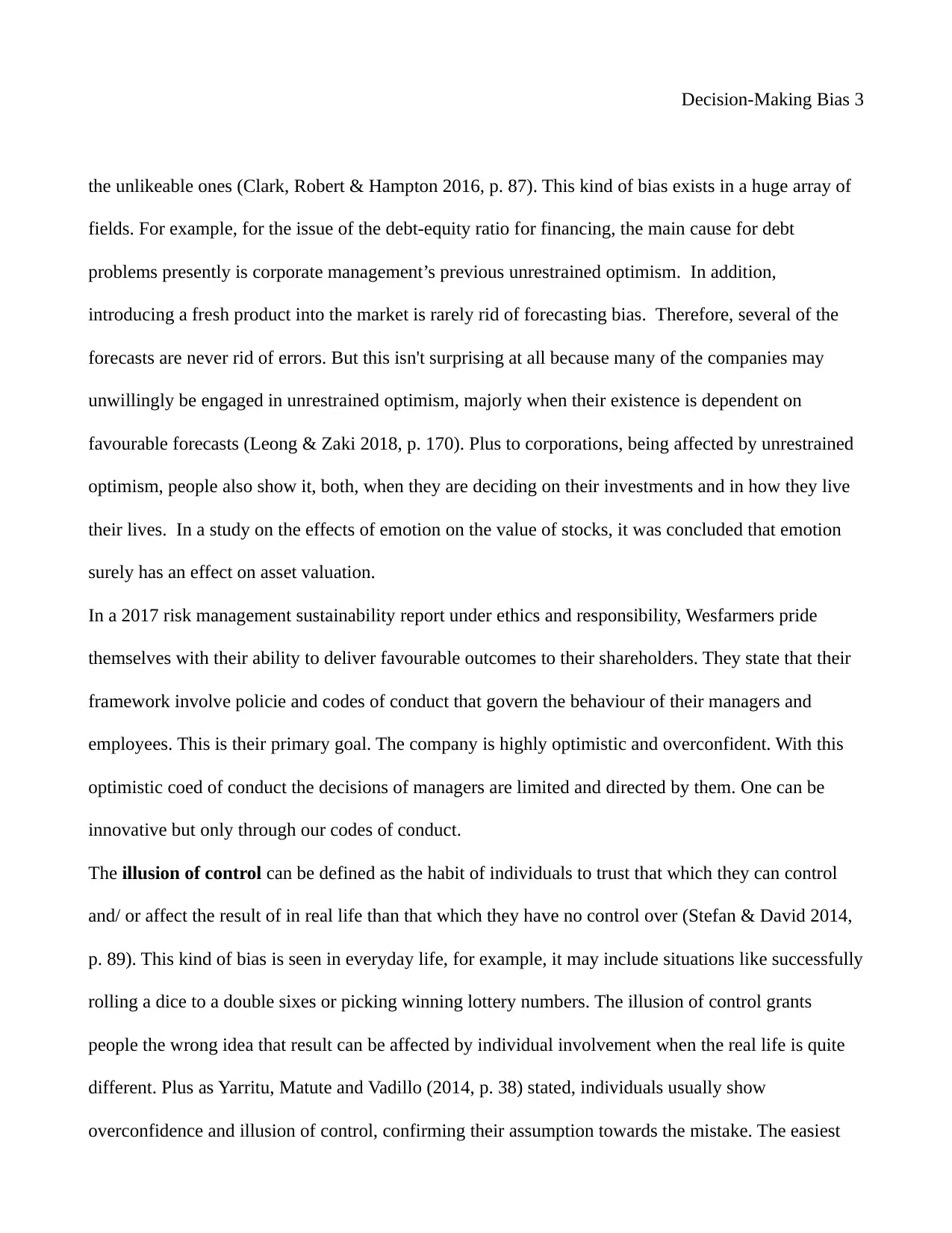
Decision-Making Bias 3
the unlikeable ones (Clark, Robert & Hampton 2016, p. 87). This kind of bias exists in a huge array of
fields. For example, for the issue of the debt-equity ratio for financing, the main cause for debt
problems presently is corporate management’s previous unrestrained optimism. In addition,
introducing a fresh product into the market is rarely rid of forecasting bias. Therefore, several of the
forecasts are never rid of errors. But this isn't surprising at all because many of the companies may
unwillingly be engaged in unrestrained optimism, majorly when their existence is dependent on
favourable forecasts (Leong & Zaki 2018, p. 170). Plus to corporations, being affected by unrestrained
optimism, people also show it, both, when they are deciding on their investments and in how they live
their lives. In a study on the effects of emotion on the value of stocks, it was concluded that emotion
surely has an effect on asset valuation.
In a 2017 risk management sustainability report under ethics and responsibility, Wesfarmers pride
themselves with their ability to deliver favourable outcomes to their shareholders. They state that their
framework involve policie and codes of conduct that govern the behaviour of their managers and
employees. This is their primary goal. The company is highly optimistic and overconfident. With this
optimistic coed of conduct the decisions of managers are limited and directed by them. One can be
innovative but only through our codes of conduct.
The illusion of control can be defined as the habit of individuals to trust that which they can control
and/ or affect the result of in real life than that which they have no control over (Stefan & David 2014,
p. 89). This kind of bias is seen in everyday life, for example, it may include situations like successfully
rolling a dice to a double sixes or picking winning lottery numbers. The illusion of control grants
people the wrong idea that result can be affected by individual involvement when the real life is quite
different. Plus as Yarritu, Matute and Vadillo (2014, p. 38) stated, individuals usually show
overconfidence and illusion of control, confirming their assumption towards the mistake. The easiest
the unlikeable ones (Clark, Robert & Hampton 2016, p. 87). This kind of bias exists in a huge array of
fields. For example, for the issue of the debt-equity ratio for financing, the main cause for debt
problems presently is corporate management’s previous unrestrained optimism. In addition,
introducing a fresh product into the market is rarely rid of forecasting bias. Therefore, several of the
forecasts are never rid of errors. But this isn't surprising at all because many of the companies may
unwillingly be engaged in unrestrained optimism, majorly when their existence is dependent on
favourable forecasts (Leong & Zaki 2018, p. 170). Plus to corporations, being affected by unrestrained
optimism, people also show it, both, when they are deciding on their investments and in how they live
their lives. In a study on the effects of emotion on the value of stocks, it was concluded that emotion
surely has an effect on asset valuation.
In a 2017 risk management sustainability report under ethics and responsibility, Wesfarmers pride
themselves with their ability to deliver favourable outcomes to their shareholders. They state that their
framework involve policie and codes of conduct that govern the behaviour of their managers and
employees. This is their primary goal. The company is highly optimistic and overconfident. With this
optimistic coed of conduct the decisions of managers are limited and directed by them. One can be
innovative but only through our codes of conduct.
The illusion of control can be defined as the habit of individuals to trust that which they can control
and/ or affect the result of in real life than that which they have no control over (Stefan & David 2014,
p. 89). This kind of bias is seen in everyday life, for example, it may include situations like successfully
rolling a dice to a double sixes or picking winning lottery numbers. The illusion of control grants
people the wrong idea that result can be affected by individual involvement when the real life is quite
different. Plus as Yarritu, Matute and Vadillo (2014, p. 38) stated, individuals usually show
overconfidence and illusion of control, confirming their assumption towards the mistake. The easiest
⊘ This is a preview!⊘
Do you want full access?
Subscribe today to unlock all pages.

Trusted by 1+ million students worldwide
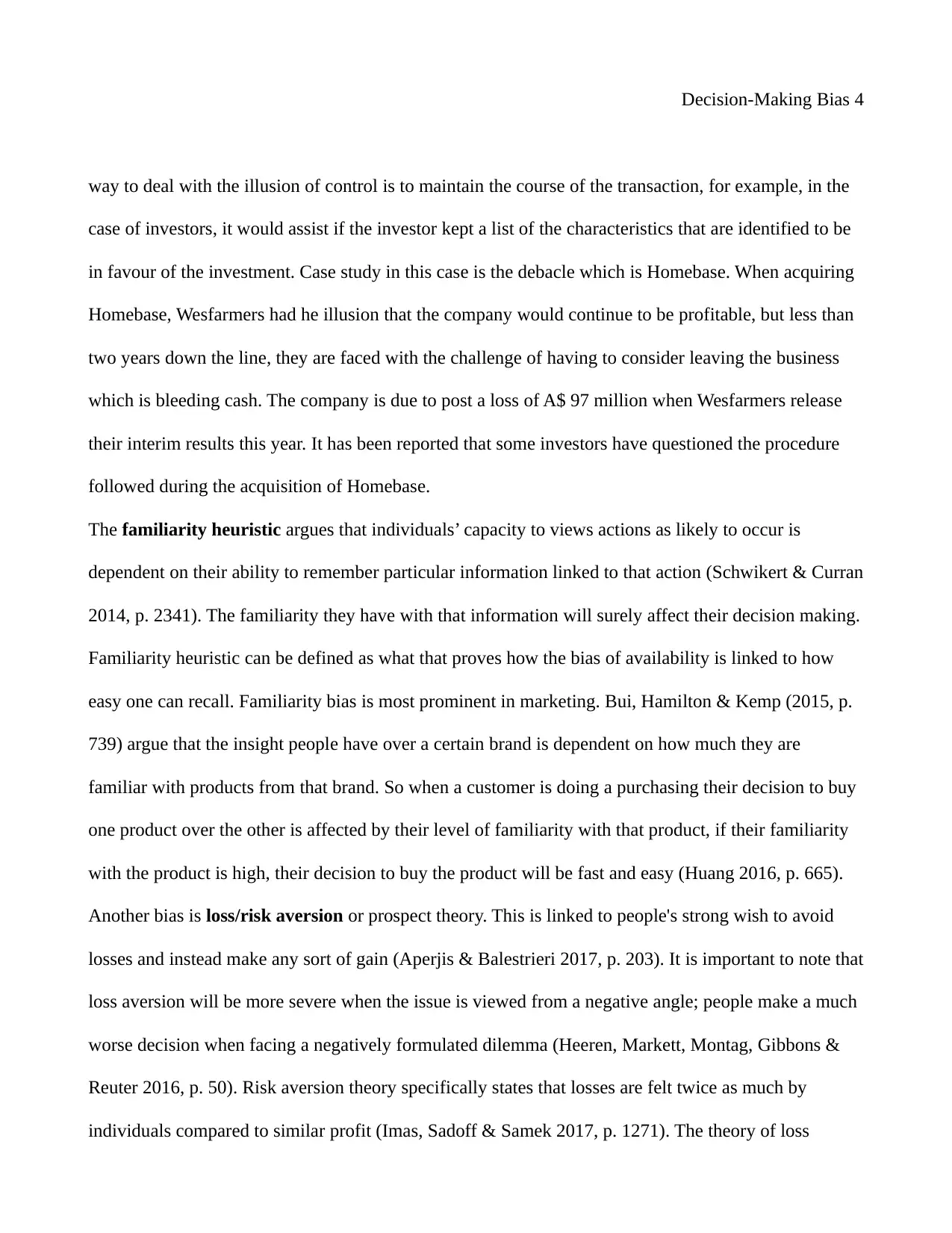
Decision-Making Bias 4
way to deal with the illusion of control is to maintain the course of the transaction, for example, in the
case of investors, it would assist if the investor kept a list of the characteristics that are identified to be
in favour of the investment. Case study in this case is the debacle which is Homebase. When acquiring
Homebase, Wesfarmers had he illusion that the company would continue to be profitable, but less than
two years down the line, they are faced with the challenge of having to consider leaving the business
which is bleeding cash. The company is due to post a loss of A$ 97 million when Wesfarmers release
their interim results this year. It has been reported that some investors have questioned the procedure
followed during the acquisition of Homebase.
The familiarity heuristic argues that individuals’ capacity to views actions as likely to occur is
dependent on their ability to remember particular information linked to that action (Schwikert & Curran
2014, p. 2341). The familiarity they have with that information will surely affect their decision making.
Familiarity heuristic can be defined as what that proves how the bias of availability is linked to how
easy one can recall. Familiarity bias is most prominent in marketing. Bui, Hamilton & Kemp (2015, p.
739) argue that the insight people have over a certain brand is dependent on how much they are
familiar with products from that brand. So when a customer is doing a purchasing their decision to buy
one product over the other is affected by their level of familiarity with that product, if their familiarity
with the product is high, their decision to buy the product will be fast and easy (Huang 2016, p. 665).
Another bias is loss/risk aversion or prospect theory. This is linked to people's strong wish to avoid
losses and instead make any sort of gain (Aperjis & Balestrieri 2017, p. 203). It is important to note that
loss aversion will be more severe when the issue is viewed from a negative angle; people make a much
worse decision when facing a negatively formulated dilemma (Heeren, Markett, Montag, Gibbons &
Reuter 2016, p. 50). Risk aversion theory specifically states that losses are felt twice as much by
individuals compared to similar profit (Imas, Sadoff & Samek 2017, p. 1271). The theory of loss
way to deal with the illusion of control is to maintain the course of the transaction, for example, in the
case of investors, it would assist if the investor kept a list of the characteristics that are identified to be
in favour of the investment. Case study in this case is the debacle which is Homebase. When acquiring
Homebase, Wesfarmers had he illusion that the company would continue to be profitable, but less than
two years down the line, they are faced with the challenge of having to consider leaving the business
which is bleeding cash. The company is due to post a loss of A$ 97 million when Wesfarmers release
their interim results this year. It has been reported that some investors have questioned the procedure
followed during the acquisition of Homebase.
The familiarity heuristic argues that individuals’ capacity to views actions as likely to occur is
dependent on their ability to remember particular information linked to that action (Schwikert & Curran
2014, p. 2341). The familiarity they have with that information will surely affect their decision making.
Familiarity heuristic can be defined as what that proves how the bias of availability is linked to how
easy one can recall. Familiarity bias is most prominent in marketing. Bui, Hamilton & Kemp (2015, p.
739) argue that the insight people have over a certain brand is dependent on how much they are
familiar with products from that brand. So when a customer is doing a purchasing their decision to buy
one product over the other is affected by their level of familiarity with that product, if their familiarity
with the product is high, their decision to buy the product will be fast and easy (Huang 2016, p. 665).
Another bias is loss/risk aversion or prospect theory. This is linked to people's strong wish to avoid
losses and instead make any sort of gain (Aperjis & Balestrieri 2017, p. 203). It is important to note that
loss aversion will be more severe when the issue is viewed from a negative angle; people make a much
worse decision when facing a negatively formulated dilemma (Heeren, Markett, Montag, Gibbons &
Reuter 2016, p. 50). Risk aversion theory specifically states that losses are felt twice as much by
individuals compared to similar profit (Imas, Sadoff & Samek 2017, p. 1271). The theory of loss
Paraphrase This Document
Need a fresh take? Get an instant paraphrase of this document with our AI Paraphraser
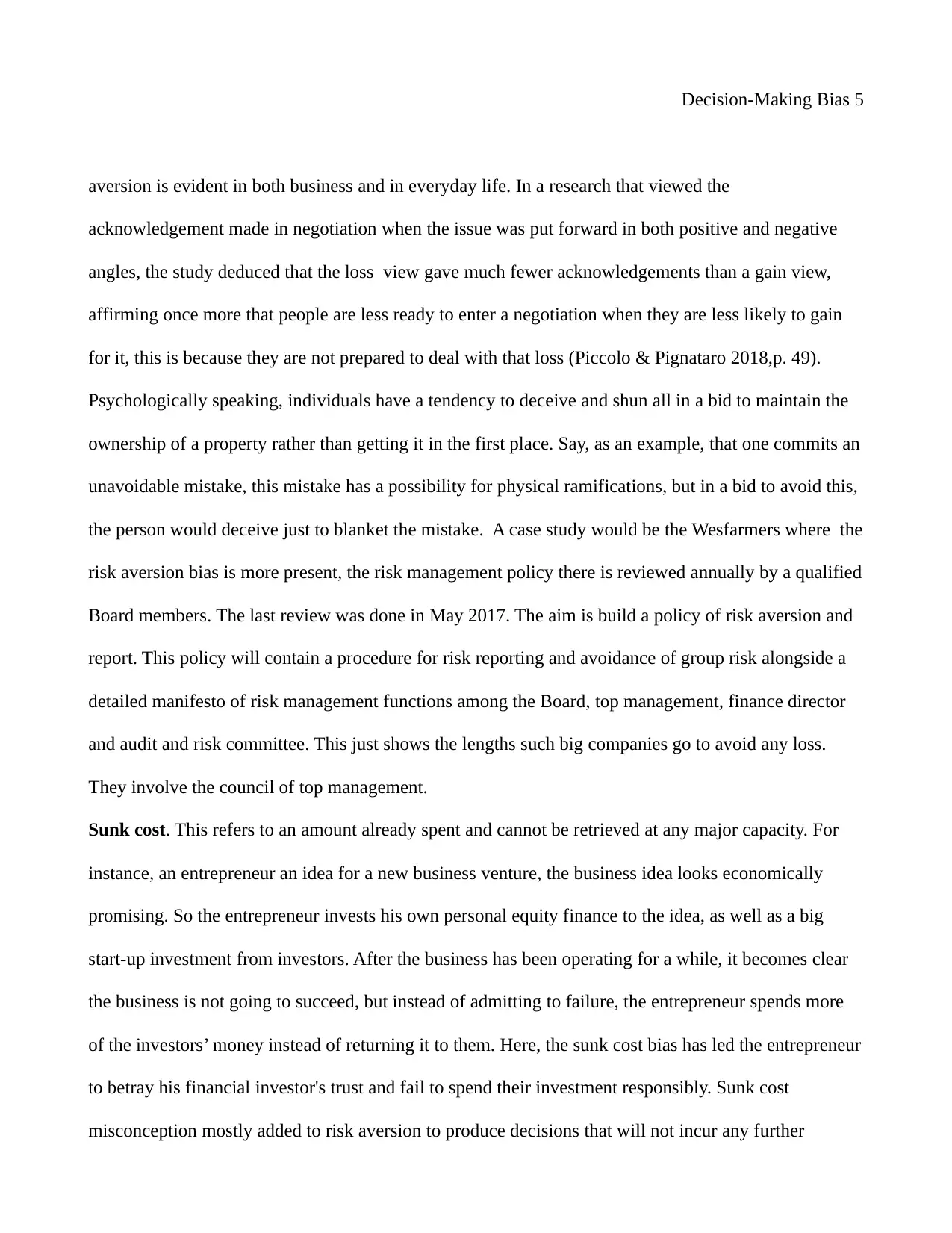
Decision-Making Bias 5
aversion is evident in both business and in everyday life. In a research that viewed the
acknowledgement made in negotiation when the issue was put forward in both positive and negative
angles, the study deduced that the loss view gave much fewer acknowledgements than a gain view,
affirming once more that people are less ready to enter a negotiation when they are less likely to gain
for it, this is because they are not prepared to deal with that loss (Piccolo & Pignataro 2018,p. 49).
Psychologically speaking, individuals have a tendency to deceive and shun all in a bid to maintain the
ownership of a property rather than getting it in the first place. Say, as an example, that one commits an
unavoidable mistake, this mistake has a possibility for physical ramifications, but in a bid to avoid this,
the person would deceive just to blanket the mistake. A case study would be the Wesfarmers where the
risk aversion bias is more present, the risk management policy there is reviewed annually by a qualified
Board members. The last review was done in May 2017. The aim is build a policy of risk aversion and
report. This policy will contain a procedure for risk reporting and avoidance of group risk alongside a
detailed manifesto of risk management functions among the Board, top management, finance director
and audit and risk committee. This just shows the lengths such big companies go to avoid any loss.
They involve the council of top management.
Sunk cost. This refers to an amount already spent and cannot be retrieved at any major capacity. For
instance, an entrepreneur an idea for a new business venture, the business idea looks economically
promising. So the entrepreneur invests his own personal equity finance to the idea, as well as a big
start-up investment from investors. After the business has been operating for a while, it becomes clear
the business is not going to succeed, but instead of admitting to failure, the entrepreneur spends more
of the investors’ money instead of returning it to them. Here, the sunk cost bias has led the entrepreneur
to betray his financial investor's trust and fail to spend their investment responsibly. Sunk cost
misconception mostly added to risk aversion to produce decisions that will not incur any further
aversion is evident in both business and in everyday life. In a research that viewed the
acknowledgement made in negotiation when the issue was put forward in both positive and negative
angles, the study deduced that the loss view gave much fewer acknowledgements than a gain view,
affirming once more that people are less ready to enter a negotiation when they are less likely to gain
for it, this is because they are not prepared to deal with that loss (Piccolo & Pignataro 2018,p. 49).
Psychologically speaking, individuals have a tendency to deceive and shun all in a bid to maintain the
ownership of a property rather than getting it in the first place. Say, as an example, that one commits an
unavoidable mistake, this mistake has a possibility for physical ramifications, but in a bid to avoid this,
the person would deceive just to blanket the mistake. A case study would be the Wesfarmers where the
risk aversion bias is more present, the risk management policy there is reviewed annually by a qualified
Board members. The last review was done in May 2017. The aim is build a policy of risk aversion and
report. This policy will contain a procedure for risk reporting and avoidance of group risk alongside a
detailed manifesto of risk management functions among the Board, top management, finance director
and audit and risk committee. This just shows the lengths such big companies go to avoid any loss.
They involve the council of top management.
Sunk cost. This refers to an amount already spent and cannot be retrieved at any major capacity. For
instance, an entrepreneur an idea for a new business venture, the business idea looks economically
promising. So the entrepreneur invests his own personal equity finance to the idea, as well as a big
start-up investment from investors. After the business has been operating for a while, it becomes clear
the business is not going to succeed, but instead of admitting to failure, the entrepreneur spends more
of the investors’ money instead of returning it to them. Here, the sunk cost bias has led the entrepreneur
to betray his financial investor's trust and fail to spend their investment responsibly. Sunk cost
misconception mostly added to risk aversion to produce decisions that will not incur any further
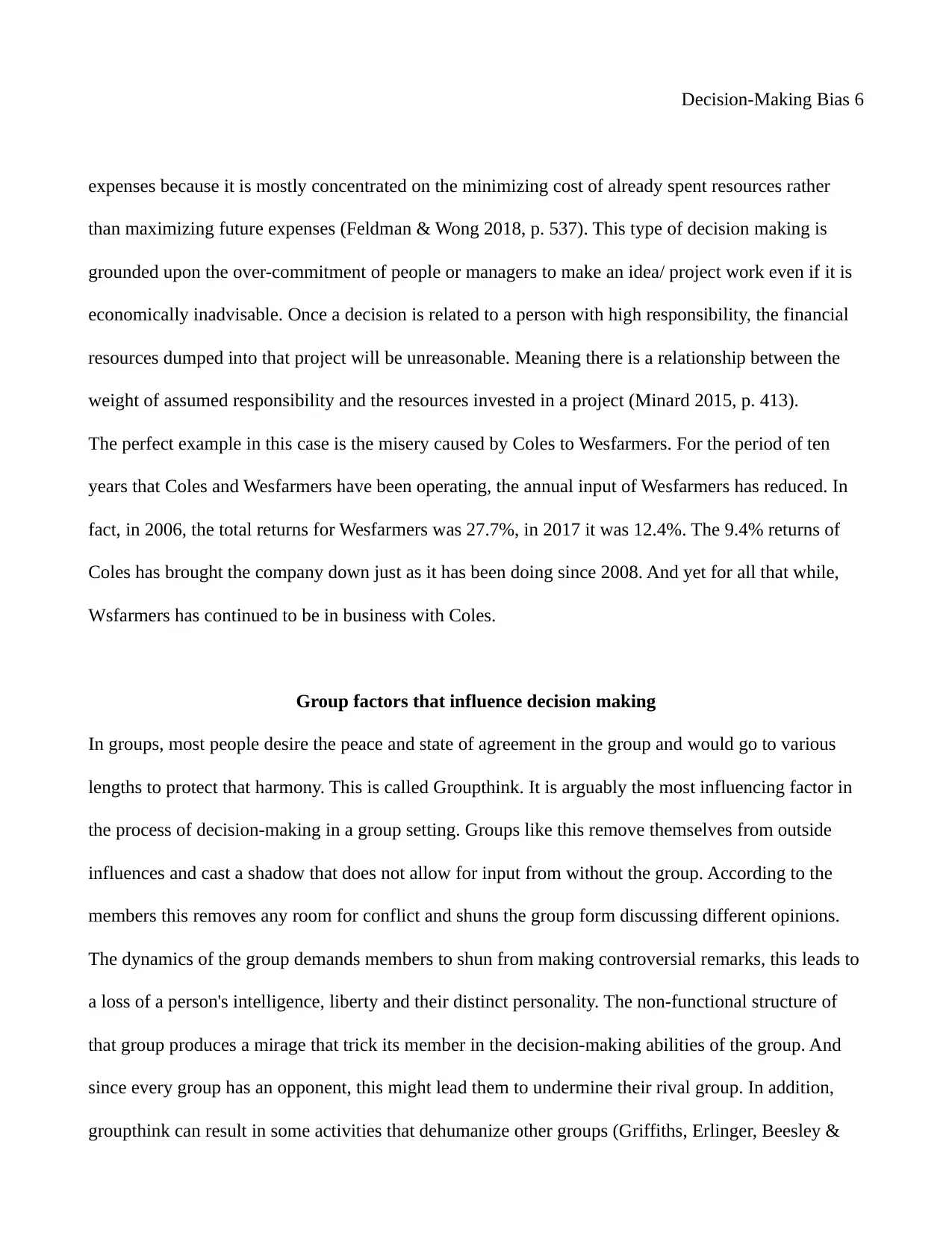
Decision-Making Bias 6
expenses because it is mostly concentrated on the minimizing cost of already spent resources rather
than maximizing future expenses (Feldman & Wong 2018, p. 537). This type of decision making is
grounded upon the over-commitment of people or managers to make an idea/ project work even if it is
economically inadvisable. Once a decision is related to a person with high responsibility, the financial
resources dumped into that project will be unreasonable. Meaning there is a relationship between the
weight of assumed responsibility and the resources invested in a project (Minard 2015, p. 413).
The perfect example in this case is the misery caused by Coles to Wesfarmers. For the period of ten
years that Coles and Wesfarmers have been operating, the annual input of Wesfarmers has reduced. In
fact, in 2006, the total returns for Wesfarmers was 27.7%, in 2017 it was 12.4%. The 9.4% returns of
Coles has brought the company down just as it has been doing since 2008. And yet for all that while,
Wsfarmers has continued to be in business with Coles.
Group factors that influence decision making
In groups, most people desire the peace and state of agreement in the group and would go to various
lengths to protect that harmony. This is called Groupthink. It is arguably the most influencing factor in
the process of decision-making in a group setting. Groups like this remove themselves from outside
influences and cast a shadow that does not allow for input from without the group. According to the
members this removes any room for conflict and shuns the group form discussing different opinions.
The dynamics of the group demands members to shun from making controversial remarks, this leads to
a loss of a person's intelligence, liberty and their distinct personality. The non-functional structure of
that group produces a mirage that trick its member in the decision-making abilities of the group. And
since every group has an opponent, this might lead them to undermine their rival group. In addition,
groupthink can result in some activities that dehumanize other groups (Griffiths, Erlinger, Beesley &
expenses because it is mostly concentrated on the minimizing cost of already spent resources rather
than maximizing future expenses (Feldman & Wong 2018, p. 537). This type of decision making is
grounded upon the over-commitment of people or managers to make an idea/ project work even if it is
economically inadvisable. Once a decision is related to a person with high responsibility, the financial
resources dumped into that project will be unreasonable. Meaning there is a relationship between the
weight of assumed responsibility and the resources invested in a project (Minard 2015, p. 413).
The perfect example in this case is the misery caused by Coles to Wesfarmers. For the period of ten
years that Coles and Wesfarmers have been operating, the annual input of Wesfarmers has reduced. In
fact, in 2006, the total returns for Wesfarmers was 27.7%, in 2017 it was 12.4%. The 9.4% returns of
Coles has brought the company down just as it has been doing since 2008. And yet for all that while,
Wsfarmers has continued to be in business with Coles.
Group factors that influence decision making
In groups, most people desire the peace and state of agreement in the group and would go to various
lengths to protect that harmony. This is called Groupthink. It is arguably the most influencing factor in
the process of decision-making in a group setting. Groups like this remove themselves from outside
influences and cast a shadow that does not allow for input from without the group. According to the
members this removes any room for conflict and shuns the group form discussing different opinions.
The dynamics of the group demands members to shun from making controversial remarks, this leads to
a loss of a person's intelligence, liberty and their distinct personality. The non-functional structure of
that group produces a mirage that trick its member in the decision-making abilities of the group. And
since every group has an opponent, this might lead them to undermine their rival group. In addition,
groupthink can result in some activities that dehumanize other groups (Griffiths, Erlinger, Beesley &
⊘ This is a preview!⊘
Do you want full access?
Subscribe today to unlock all pages.

Trusted by 1+ million students worldwide
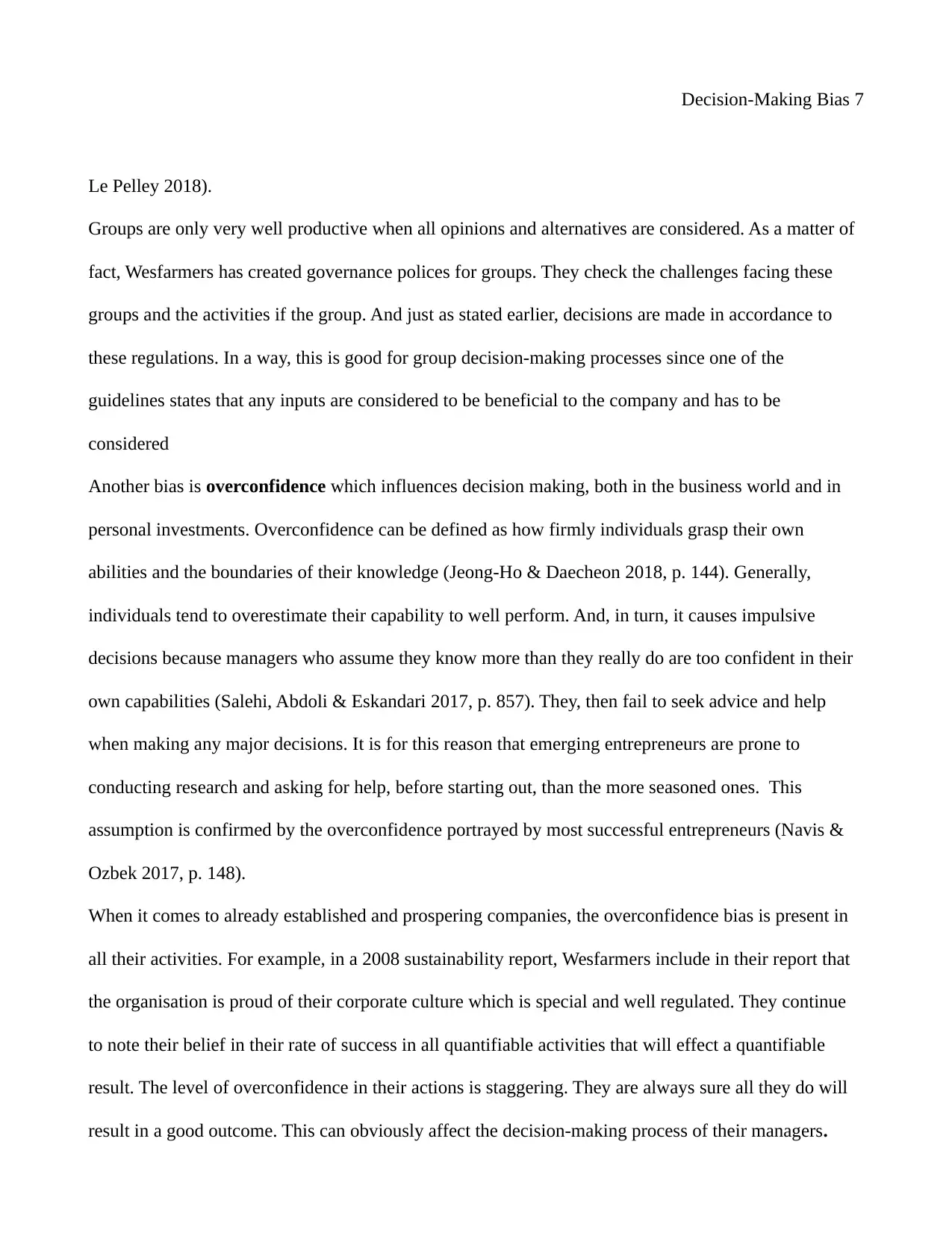
Decision-Making Bias 7
Le Pelley 2018).
Groups are only very well productive when all opinions and alternatives are considered. As a matter of
fact, Wesfarmers has created governance polices for groups. They check the challenges facing these
groups and the activities if the group. And just as stated earlier, decisions are made in accordance to
these regulations. In a way, this is good for group decision-making processes since one of the
guidelines states that any inputs are considered to be beneficial to the company and has to be
considered
Another bias is overconfidence which influences decision making, both in the business world and in
personal investments. Overconfidence can be defined as how firmly individuals grasp their own
abilities and the boundaries of their knowledge (Jeong-Ho & Daecheon 2018, p. 144). Generally,
individuals tend to overestimate their capability to well perform. And, in turn, it causes impulsive
decisions because managers who assume they know more than they really do are too confident in their
own capabilities (Salehi, Abdoli & Eskandari 2017, p. 857). They, then fail to seek advice and help
when making any major decisions. It is for this reason that emerging entrepreneurs are prone to
conducting research and asking for help, before starting out, than the more seasoned ones. This
assumption is confirmed by the overconfidence portrayed by most successful entrepreneurs (Navis &
Ozbek 2017, p. 148).
When it comes to already established and prospering companies, the overconfidence bias is present in
all their activities. For example, in a 2008 sustainability report, Wesfarmers include in their report that
the organisation is proud of their corporate culture which is special and well regulated. They continue
to note their belief in their rate of success in all quantifiable activities that will effect a quantifiable
result. The level of overconfidence in their actions is staggering. They are always sure all they do will
result in a good outcome. This can obviously affect the decision-making process of their managers.
Le Pelley 2018).
Groups are only very well productive when all opinions and alternatives are considered. As a matter of
fact, Wesfarmers has created governance polices for groups. They check the challenges facing these
groups and the activities if the group. And just as stated earlier, decisions are made in accordance to
these regulations. In a way, this is good for group decision-making processes since one of the
guidelines states that any inputs are considered to be beneficial to the company and has to be
considered
Another bias is overconfidence which influences decision making, both in the business world and in
personal investments. Overconfidence can be defined as how firmly individuals grasp their own
abilities and the boundaries of their knowledge (Jeong-Ho & Daecheon 2018, p. 144). Generally,
individuals tend to overestimate their capability to well perform. And, in turn, it causes impulsive
decisions because managers who assume they know more than they really do are too confident in their
own capabilities (Salehi, Abdoli & Eskandari 2017, p. 857). They, then fail to seek advice and help
when making any major decisions. It is for this reason that emerging entrepreneurs are prone to
conducting research and asking for help, before starting out, than the more seasoned ones. This
assumption is confirmed by the overconfidence portrayed by most successful entrepreneurs (Navis &
Ozbek 2017, p. 148).
When it comes to already established and prospering companies, the overconfidence bias is present in
all their activities. For example, in a 2008 sustainability report, Wesfarmers include in their report that
the organisation is proud of their corporate culture which is special and well regulated. They continue
to note their belief in their rate of success in all quantifiable activities that will effect a quantifiable
result. The level of overconfidence in their actions is staggering. They are always sure all they do will
result in a good outcome. This can obviously affect the decision-making process of their managers.
Paraphrase This Document
Need a fresh take? Get an instant paraphrase of this document with our AI Paraphraser
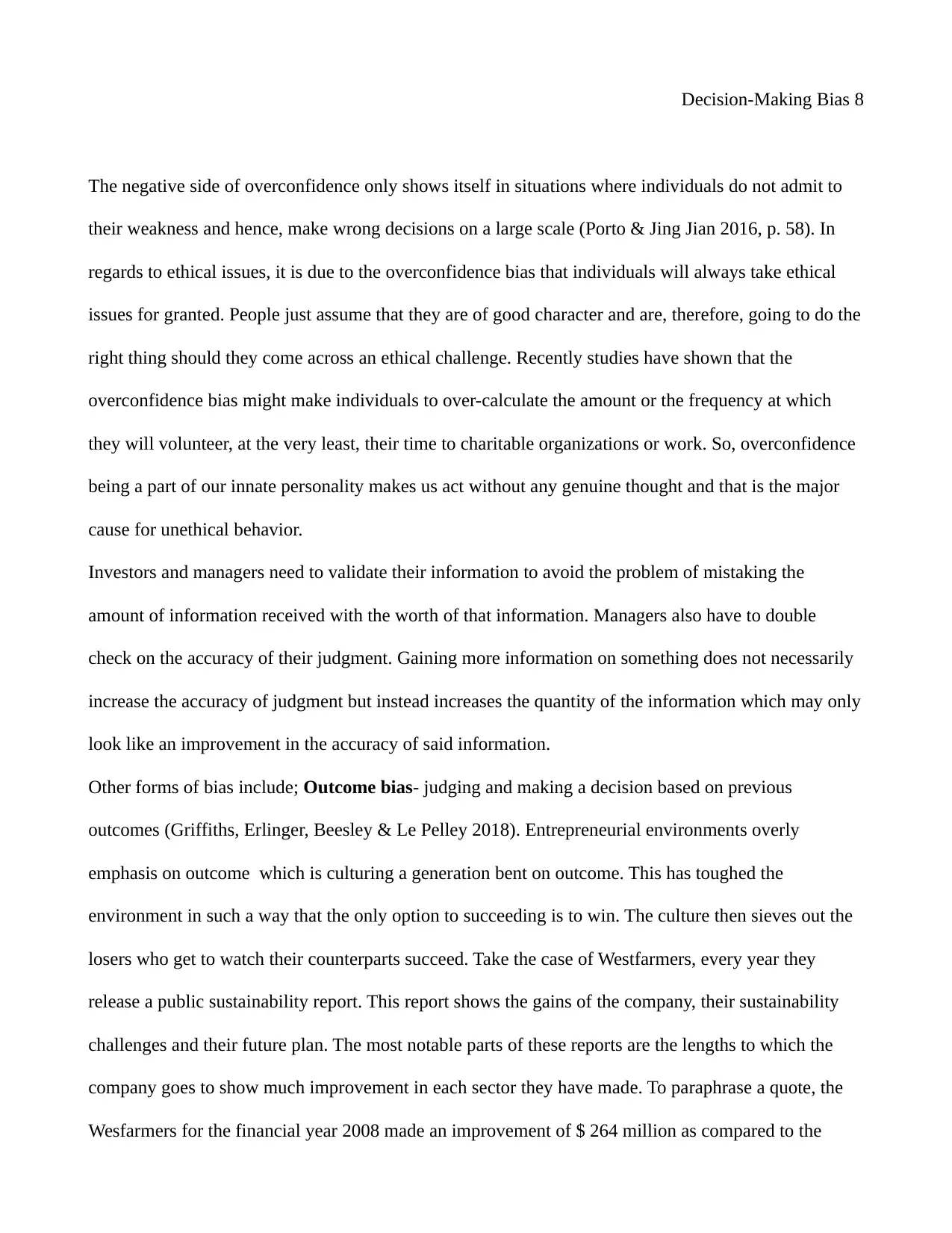
Decision-Making Bias 8
The negative side of overconfidence only shows itself in situations where individuals do not admit to
their weakness and hence, make wrong decisions on a large scale (Porto & Jing Jian 2016, p. 58). In
regards to ethical issues, it is due to the overconfidence bias that individuals will always take ethical
issues for granted. People just assume that they are of good character and are, therefore, going to do the
right thing should they come across an ethical challenge. Recently studies have shown that the
overconfidence bias might make individuals to over-calculate the amount or the frequency at which
they will volunteer, at the very least, their time to charitable organizations or work. So, overconfidence
being a part of our innate personality makes us act without any genuine thought and that is the major
cause for unethical behavior.
Investors and managers need to validate their information to avoid the problem of mistaking the
amount of information received with the worth of that information. Managers also have to double
check on the accuracy of their judgment. Gaining more information on something does not necessarily
increase the accuracy of judgment but instead increases the quantity of the information which may only
look like an improvement in the accuracy of said information.
Other forms of bias include; Outcome bias- judging and making a decision based on previous
outcomes (Griffiths, Erlinger, Beesley & Le Pelley 2018). Entrepreneurial environments overly
emphasis on outcome which is culturing a generation bent on outcome. This has toughed the
environment in such a way that the only option to succeeding is to win. The culture then sieves out the
losers who get to watch their counterparts succeed. Take the case of Westfarmers, every year they
release a public sustainability report. This report shows the gains of the company, their sustainability
challenges and their future plan. The most notable parts of these reports are the lengths to which the
company goes to show much improvement in each sector they have made. To paraphrase a quote, the
Wesfarmers for the financial year 2008 made an improvement of $ 264 million as compared to the
The negative side of overconfidence only shows itself in situations where individuals do not admit to
their weakness and hence, make wrong decisions on a large scale (Porto & Jing Jian 2016, p. 58). In
regards to ethical issues, it is due to the overconfidence bias that individuals will always take ethical
issues for granted. People just assume that they are of good character and are, therefore, going to do the
right thing should they come across an ethical challenge. Recently studies have shown that the
overconfidence bias might make individuals to over-calculate the amount or the frequency at which
they will volunteer, at the very least, their time to charitable organizations or work. So, overconfidence
being a part of our innate personality makes us act without any genuine thought and that is the major
cause for unethical behavior.
Investors and managers need to validate their information to avoid the problem of mistaking the
amount of information received with the worth of that information. Managers also have to double
check on the accuracy of their judgment. Gaining more information on something does not necessarily
increase the accuracy of judgment but instead increases the quantity of the information which may only
look like an improvement in the accuracy of said information.
Other forms of bias include; Outcome bias- judging and making a decision based on previous
outcomes (Griffiths, Erlinger, Beesley & Le Pelley 2018). Entrepreneurial environments overly
emphasis on outcome which is culturing a generation bent on outcome. This has toughed the
environment in such a way that the only option to succeeding is to win. The culture then sieves out the
losers who get to watch their counterparts succeed. Take the case of Westfarmers, every year they
release a public sustainability report. This report shows the gains of the company, their sustainability
challenges and their future plan. The most notable parts of these reports are the lengths to which the
company goes to show much improvement in each sector they have made. To paraphrase a quote, the
Wesfarmers for the financial year 2008 made an improvement of $ 264 million as compared to the
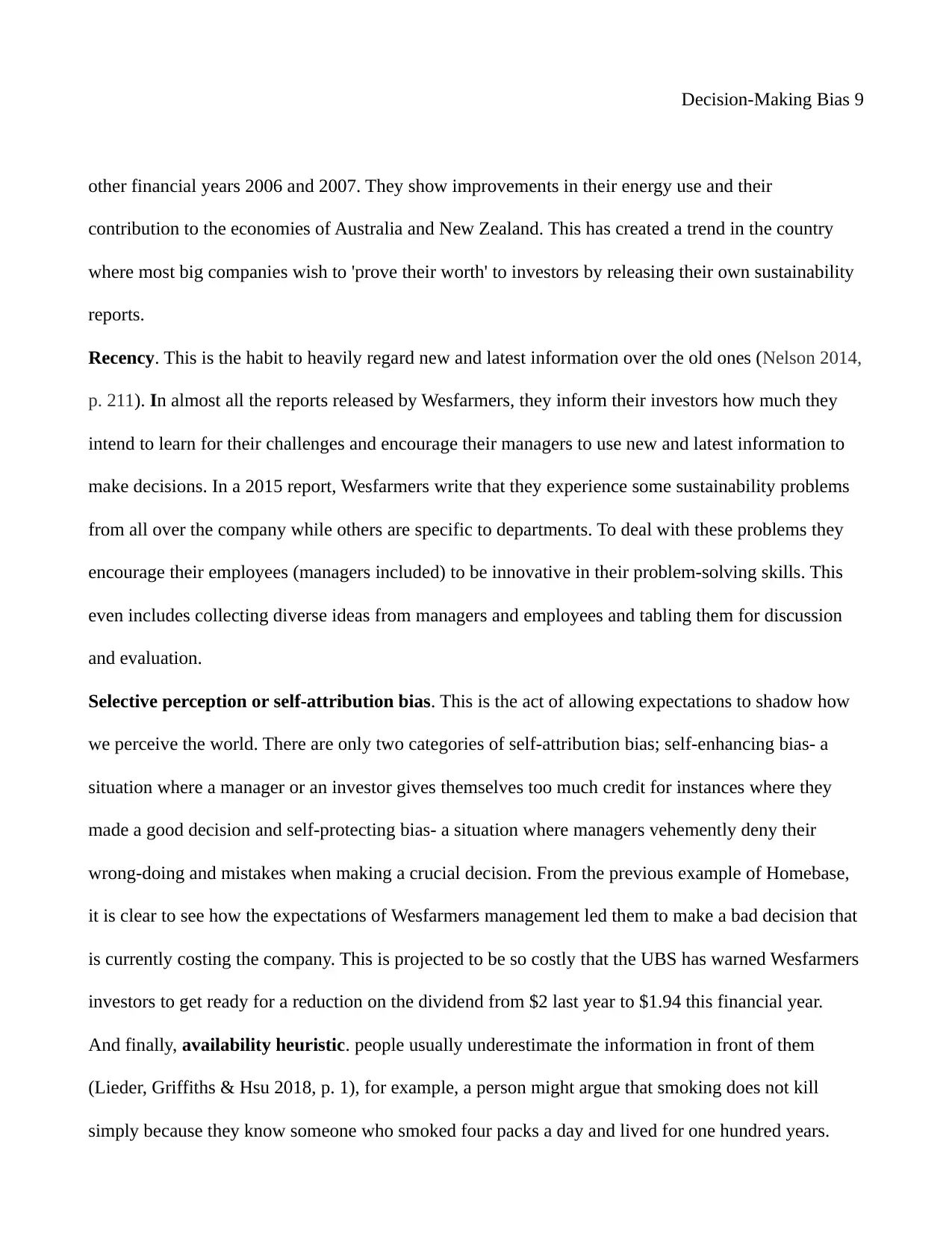
Decision-Making Bias 9
other financial years 2006 and 2007. They show improvements in their energy use and their
contribution to the economies of Australia and New Zealand. This has created a trend in the country
where most big companies wish to 'prove their worth' to investors by releasing their own sustainability
reports.
Recency. This is the habit to heavily regard new and latest information over the old ones (Nelson 2014,
p. 211). In almost all the reports released by Wesfarmers, they inform their investors how much they
intend to learn for their challenges and encourage their managers to use new and latest information to
make decisions. In a 2015 report, Wesfarmers write that they experience some sustainability problems
from all over the company while others are specific to departments. To deal with these problems they
encourage their employees (managers included) to be innovative in their problem-solving skills. This
even includes collecting diverse ideas from managers and employees and tabling them for discussion
and evaluation.
Selective perception or self-attribution bias. This is the act of allowing expectations to shadow how
we perceive the world. There are only two categories of self-attribution bias; self-enhancing bias- a
situation where a manager or an investor gives themselves too much credit for instances where they
made a good decision and self-protecting bias- a situation where managers vehemently deny their
wrong-doing and mistakes when making a crucial decision. From the previous example of Homebase,
it is clear to see how the expectations of Wesfarmers management led them to make a bad decision that
is currently costing the company. This is projected to be so costly that the UBS has warned Wesfarmers
investors to get ready for a reduction on the dividend from $2 last year to $1.94 this financial year.
And finally, availability heuristic. people usually underestimate the information in front of them
(Lieder, Griffiths & Hsu 2018, p. 1), for example, a person might argue that smoking does not kill
simply because they know someone who smoked four packs a day and lived for one hundred years.
other financial years 2006 and 2007. They show improvements in their energy use and their
contribution to the economies of Australia and New Zealand. This has created a trend in the country
where most big companies wish to 'prove their worth' to investors by releasing their own sustainability
reports.
Recency. This is the habit to heavily regard new and latest information over the old ones (Nelson 2014,
p. 211). In almost all the reports released by Wesfarmers, they inform their investors how much they
intend to learn for their challenges and encourage their managers to use new and latest information to
make decisions. In a 2015 report, Wesfarmers write that they experience some sustainability problems
from all over the company while others are specific to departments. To deal with these problems they
encourage their employees (managers included) to be innovative in their problem-solving skills. This
even includes collecting diverse ideas from managers and employees and tabling them for discussion
and evaluation.
Selective perception or self-attribution bias. This is the act of allowing expectations to shadow how
we perceive the world. There are only two categories of self-attribution bias; self-enhancing bias- a
situation where a manager or an investor gives themselves too much credit for instances where they
made a good decision and self-protecting bias- a situation where managers vehemently deny their
wrong-doing and mistakes when making a crucial decision. From the previous example of Homebase,
it is clear to see how the expectations of Wesfarmers management led them to make a bad decision that
is currently costing the company. This is projected to be so costly that the UBS has warned Wesfarmers
investors to get ready for a reduction on the dividend from $2 last year to $1.94 this financial year.
And finally, availability heuristic. people usually underestimate the information in front of them
(Lieder, Griffiths & Hsu 2018, p. 1), for example, a person might argue that smoking does not kill
simply because they know someone who smoked four packs a day and lived for one hundred years.
⊘ This is a preview!⊘
Do you want full access?
Subscribe today to unlock all pages.

Trusted by 1+ million students worldwide
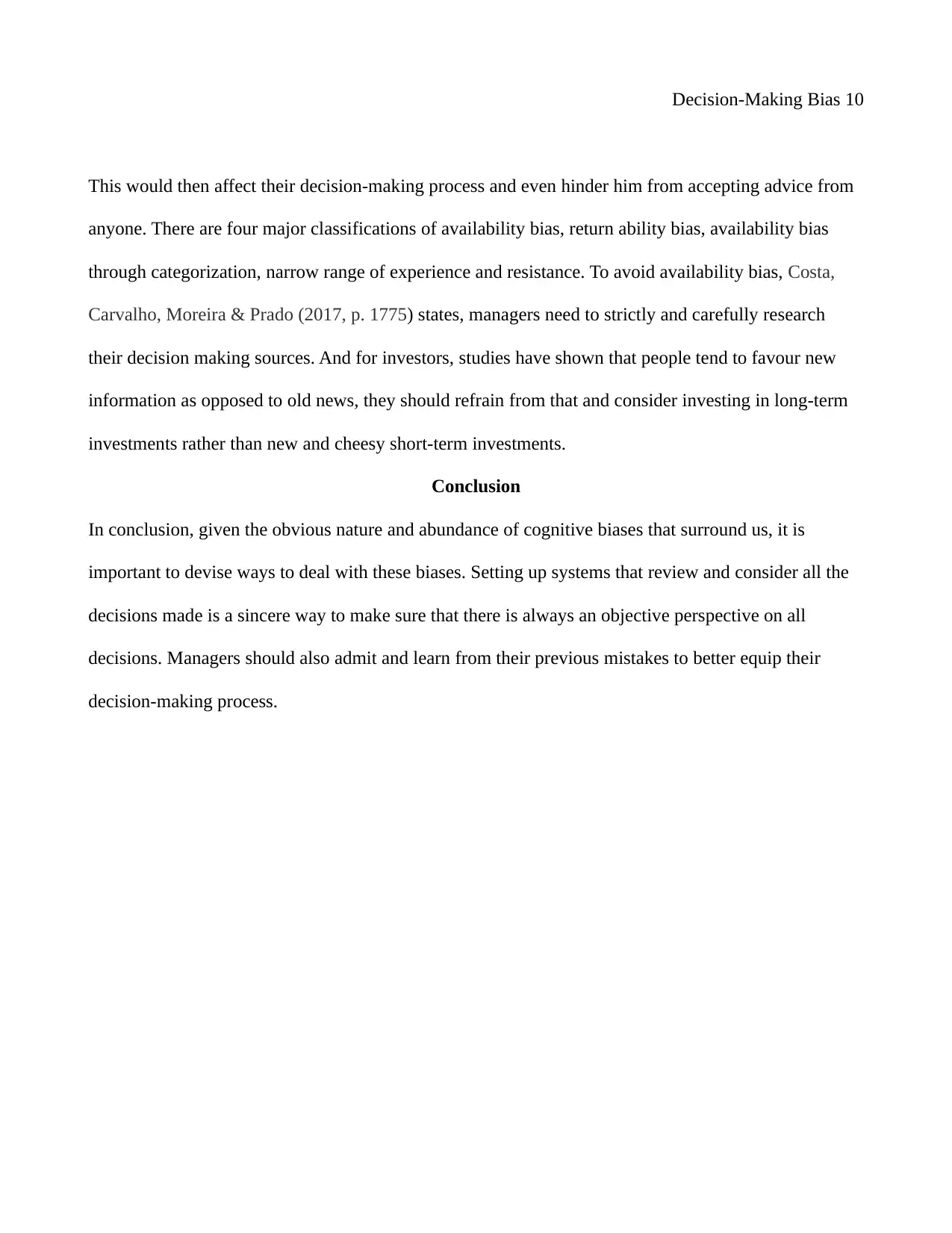
Decision-Making Bias 10
This would then affect their decision-making process and even hinder him from accepting advice from
anyone. There are four major classifications of availability bias, return ability bias, availability bias
through categorization, narrow range of experience and resistance. To avoid availability bias, Costa,
Carvalho, Moreira & Prado (2017, p. 1775) states, managers need to strictly and carefully research
their decision making sources. And for investors, studies have shown that people tend to favour new
information as opposed to old news, they should refrain from that and consider investing in long-term
investments rather than new and cheesy short-term investments.
Conclusion
In conclusion, given the obvious nature and abundance of cognitive biases that surround us, it is
important to devise ways to deal with these biases. Setting up systems that review and consider all the
decisions made is a sincere way to make sure that there is always an objective perspective on all
decisions. Managers should also admit and learn from their previous mistakes to better equip their
decision-making process.
This would then affect their decision-making process and even hinder him from accepting advice from
anyone. There are four major classifications of availability bias, return ability bias, availability bias
through categorization, narrow range of experience and resistance. To avoid availability bias, Costa,
Carvalho, Moreira & Prado (2017, p. 1775) states, managers need to strictly and carefully research
their decision making sources. And for investors, studies have shown that people tend to favour new
information as opposed to old news, they should refrain from that and consider investing in long-term
investments rather than new and cheesy short-term investments.
Conclusion
In conclusion, given the obvious nature and abundance of cognitive biases that surround us, it is
important to devise ways to deal with these biases. Setting up systems that review and consider all the
decisions made is a sincere way to make sure that there is always an objective perspective on all
decisions. Managers should also admit and learn from their previous mistakes to better equip their
decision-making process.
Paraphrase This Document
Need a fresh take? Get an instant paraphrase of this document with our AI Paraphraser
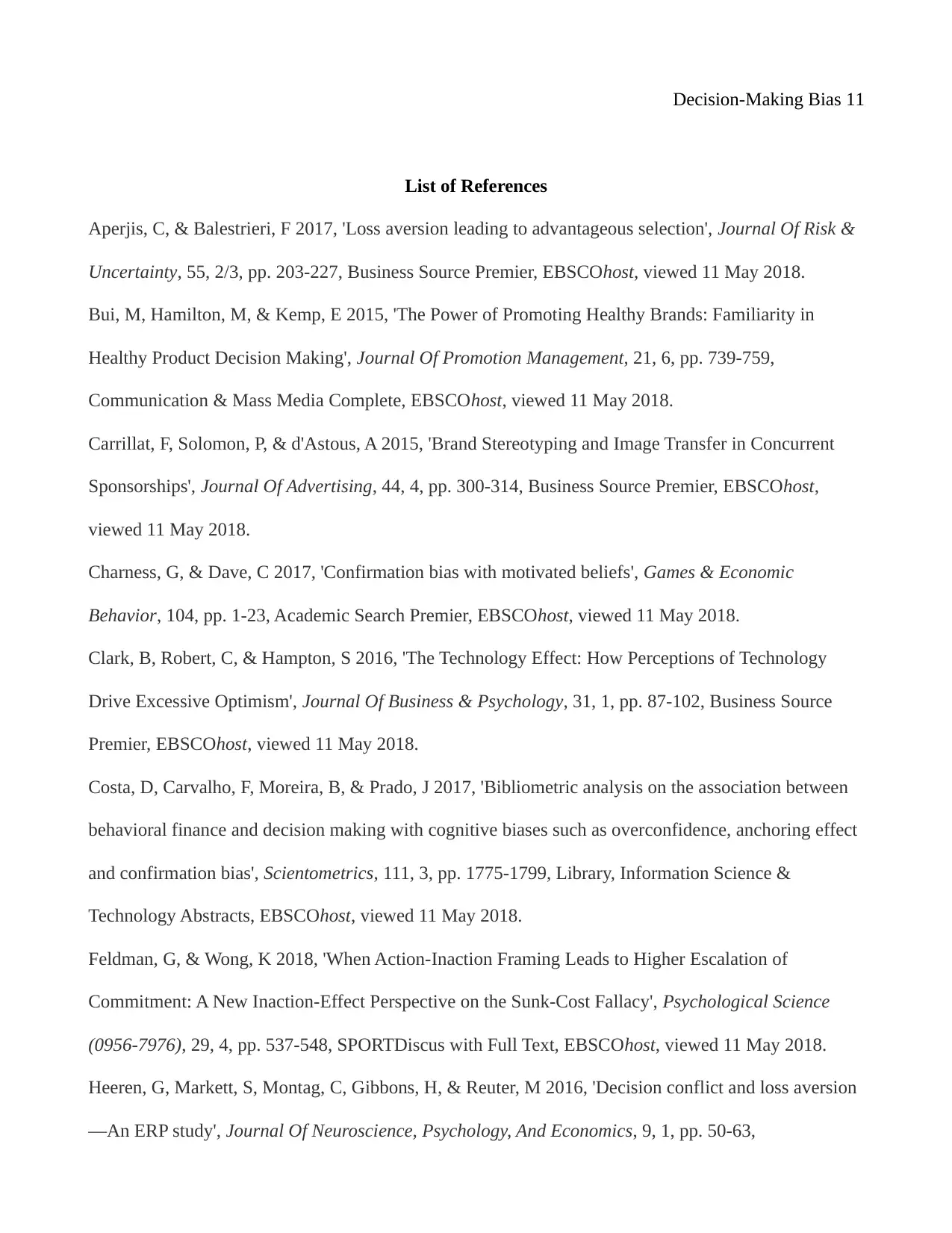
Decision-Making Bias 11
List of References
Aperjis, C, & Balestrieri, F 2017, 'Loss aversion leading to advantageous selection', Journal Of Risk &
Uncertainty, 55, 2/3, pp. 203-227, Business Source Premier, EBSCOhost, viewed 11 May 2018.
Bui, M, Hamilton, M, & Kemp, E 2015, 'The Power of Promoting Healthy Brands: Familiarity in
Healthy Product Decision Making', Journal Of Promotion Management, 21, 6, pp. 739-759,
Communication & Mass Media Complete, EBSCOhost, viewed 11 May 2018.
Carrillat, F, Solomon, P, & d'Astous, A 2015, 'Brand Stereotyping and Image Transfer in Concurrent
Sponsorships', Journal Of Advertising, 44, 4, pp. 300-314, Business Source Premier, EBSCOhost,
viewed 11 May 2018.
Charness, G, & Dave, C 2017, 'Confirmation bias with motivated beliefs', Games & Economic
Behavior, 104, pp. 1-23, Academic Search Premier, EBSCOhost, viewed 11 May 2018.
Clark, B, Robert, C, & Hampton, S 2016, 'The Technology Effect: How Perceptions of Technology
Drive Excessive Optimism', Journal Of Business & Psychology, 31, 1, pp. 87-102, Business Source
Premier, EBSCOhost, viewed 11 May 2018.
Costa, D, Carvalho, F, Moreira, B, & Prado, J 2017, 'Bibliometric analysis on the association between
behavioral finance and decision making with cognitive biases such as overconfidence, anchoring effect
and confirmation bias', Scientometrics, 111, 3, pp. 1775-1799, Library, Information Science &
Technology Abstracts, EBSCOhost, viewed 11 May 2018.
Feldman, G, & Wong, K 2018, 'When Action-Inaction Framing Leads to Higher Escalation of
Commitment: A New Inaction-Effect Perspective on the Sunk-Cost Fallacy', Psychological Science
(0956-7976), 29, 4, pp. 537-548, SPORTDiscus with Full Text, EBSCOhost, viewed 11 May 2018.
Heeren, G, Markett, S, Montag, C, Gibbons, H, & Reuter, M 2016, 'Decision conflict and loss aversion
—An ERP study', Journal Of Neuroscience, Psychology, And Economics, 9, 1, pp. 50-63,
List of References
Aperjis, C, & Balestrieri, F 2017, 'Loss aversion leading to advantageous selection', Journal Of Risk &
Uncertainty, 55, 2/3, pp. 203-227, Business Source Premier, EBSCOhost, viewed 11 May 2018.
Bui, M, Hamilton, M, & Kemp, E 2015, 'The Power of Promoting Healthy Brands: Familiarity in
Healthy Product Decision Making', Journal Of Promotion Management, 21, 6, pp. 739-759,
Communication & Mass Media Complete, EBSCOhost, viewed 11 May 2018.
Carrillat, F, Solomon, P, & d'Astous, A 2015, 'Brand Stereotyping and Image Transfer in Concurrent
Sponsorships', Journal Of Advertising, 44, 4, pp. 300-314, Business Source Premier, EBSCOhost,
viewed 11 May 2018.
Charness, G, & Dave, C 2017, 'Confirmation bias with motivated beliefs', Games & Economic
Behavior, 104, pp. 1-23, Academic Search Premier, EBSCOhost, viewed 11 May 2018.
Clark, B, Robert, C, & Hampton, S 2016, 'The Technology Effect: How Perceptions of Technology
Drive Excessive Optimism', Journal Of Business & Psychology, 31, 1, pp. 87-102, Business Source
Premier, EBSCOhost, viewed 11 May 2018.
Costa, D, Carvalho, F, Moreira, B, & Prado, J 2017, 'Bibliometric analysis on the association between
behavioral finance and decision making with cognitive biases such as overconfidence, anchoring effect
and confirmation bias', Scientometrics, 111, 3, pp. 1775-1799, Library, Information Science &
Technology Abstracts, EBSCOhost, viewed 11 May 2018.
Feldman, G, & Wong, K 2018, 'When Action-Inaction Framing Leads to Higher Escalation of
Commitment: A New Inaction-Effect Perspective on the Sunk-Cost Fallacy', Psychological Science
(0956-7976), 29, 4, pp. 537-548, SPORTDiscus with Full Text, EBSCOhost, viewed 11 May 2018.
Heeren, G, Markett, S, Montag, C, Gibbons, H, & Reuter, M 2016, 'Decision conflict and loss aversion
—An ERP study', Journal Of Neuroscience, Psychology, And Economics, 9, 1, pp. 50-63,
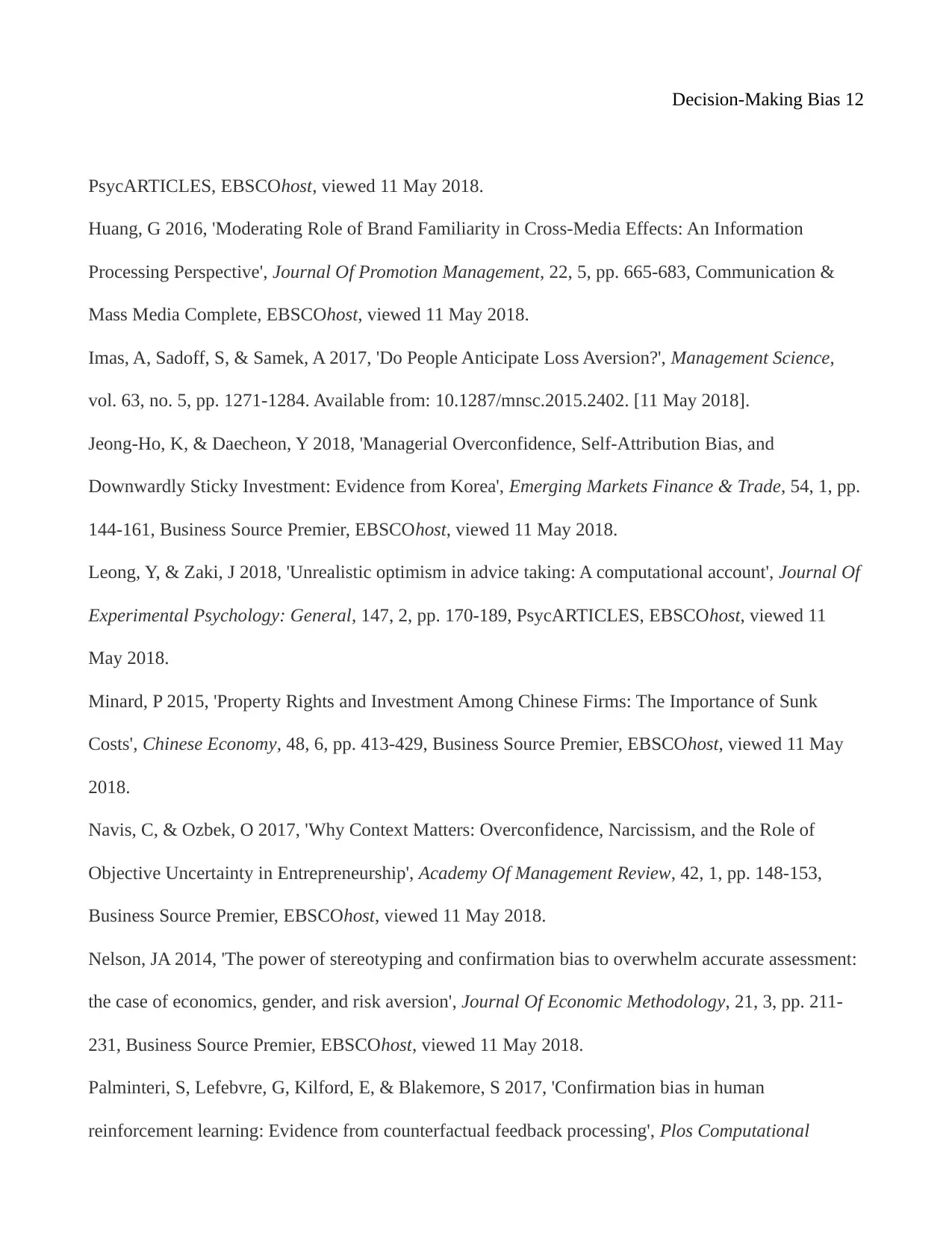
Decision-Making Bias 12
PsycARTICLES, EBSCOhost, viewed 11 May 2018.
Huang, G 2016, 'Moderating Role of Brand Familiarity in Cross-Media Effects: An Information
Processing Perspective', Journal Of Promotion Management, 22, 5, pp. 665-683, Communication &
Mass Media Complete, EBSCOhost, viewed 11 May 2018.
Imas, A, Sadoff, S, & Samek, A 2017, 'Do People Anticipate Loss Aversion?', Management Science,
vol. 63, no. 5, pp. 1271-1284. Available from: 10.1287/mnsc.2015.2402. [11 May 2018].
Jeong-Ho, K, & Daecheon, Y 2018, 'Managerial Overconfidence, Self-Attribution Bias, and
Downwardly Sticky Investment: Evidence from Korea', Emerging Markets Finance & Trade, 54, 1, pp.
144-161, Business Source Premier, EBSCOhost, viewed 11 May 2018.
Leong, Y, & Zaki, J 2018, 'Unrealistic optimism in advice taking: A computational account', Journal Of
Experimental Psychology: General, 147, 2, pp. 170-189, PsycARTICLES, EBSCOhost, viewed 11
May 2018.
Minard, P 2015, 'Property Rights and Investment Among Chinese Firms: The Importance of Sunk
Costs', Chinese Economy, 48, 6, pp. 413-429, Business Source Premier, EBSCOhost, viewed 11 May
2018.
Navis, C, & Ozbek, O 2017, 'Why Context Matters: Overconfidence, Narcissism, and the Role of
Objective Uncertainty in Entrepreneurship', Academy Of Management Review, 42, 1, pp. 148-153,
Business Source Premier, EBSCOhost, viewed 11 May 2018.
Nelson, JA 2014, 'The power of stereotyping and confirmation bias to overwhelm accurate assessment:
the case of economics, gender, and risk aversion', Journal Of Economic Methodology, 21, 3, pp. 211-
231, Business Source Premier, EBSCOhost, viewed 11 May 2018.
Palminteri, S, Lefebvre, G, Kilford, E, & Blakemore, S 2017, 'Confirmation bias in human
reinforcement learning: Evidence from counterfactual feedback processing', Plos Computational
PsycARTICLES, EBSCOhost, viewed 11 May 2018.
Huang, G 2016, 'Moderating Role of Brand Familiarity in Cross-Media Effects: An Information
Processing Perspective', Journal Of Promotion Management, 22, 5, pp. 665-683, Communication &
Mass Media Complete, EBSCOhost, viewed 11 May 2018.
Imas, A, Sadoff, S, & Samek, A 2017, 'Do People Anticipate Loss Aversion?', Management Science,
vol. 63, no. 5, pp. 1271-1284. Available from: 10.1287/mnsc.2015.2402. [11 May 2018].
Jeong-Ho, K, & Daecheon, Y 2018, 'Managerial Overconfidence, Self-Attribution Bias, and
Downwardly Sticky Investment: Evidence from Korea', Emerging Markets Finance & Trade, 54, 1, pp.
144-161, Business Source Premier, EBSCOhost, viewed 11 May 2018.
Leong, Y, & Zaki, J 2018, 'Unrealistic optimism in advice taking: A computational account', Journal Of
Experimental Psychology: General, 147, 2, pp. 170-189, PsycARTICLES, EBSCOhost, viewed 11
May 2018.
Minard, P 2015, 'Property Rights and Investment Among Chinese Firms: The Importance of Sunk
Costs', Chinese Economy, 48, 6, pp. 413-429, Business Source Premier, EBSCOhost, viewed 11 May
2018.
Navis, C, & Ozbek, O 2017, 'Why Context Matters: Overconfidence, Narcissism, and the Role of
Objective Uncertainty in Entrepreneurship', Academy Of Management Review, 42, 1, pp. 148-153,
Business Source Premier, EBSCOhost, viewed 11 May 2018.
Nelson, JA 2014, 'The power of stereotyping and confirmation bias to overwhelm accurate assessment:
the case of economics, gender, and risk aversion', Journal Of Economic Methodology, 21, 3, pp. 211-
231, Business Source Premier, EBSCOhost, viewed 11 May 2018.
Palminteri, S, Lefebvre, G, Kilford, E, & Blakemore, S 2017, 'Confirmation bias in human
reinforcement learning: Evidence from counterfactual feedback processing', Plos Computational
⊘ This is a preview!⊘
Do you want full access?
Subscribe today to unlock all pages.

Trusted by 1+ million students worldwide
1 out of 13
Your All-in-One AI-Powered Toolkit for Academic Success.
+13062052269
info@desklib.com
Available 24*7 on WhatsApp / Email
![[object Object]](/_next/static/media/star-bottom.7253800d.svg)
Unlock your academic potential
Copyright © 2020–2025 A2Z Services. All Rights Reserved. Developed and managed by ZUCOL.

